Financial Accounting: Concepts and Techniques
Added on 2023-01-12
21 Pages4301 Words64 Views
FINANCIAL ACCOUNTING
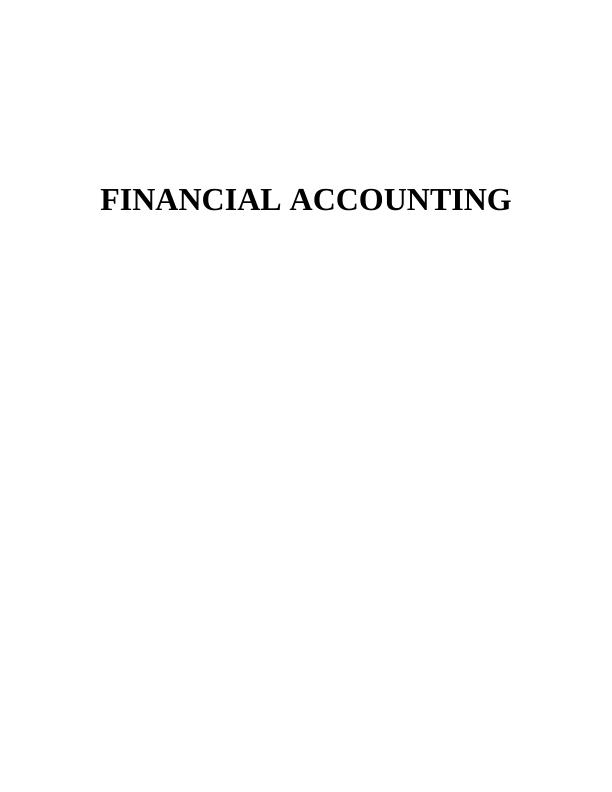
TABLE OF CONTENTS
TABLE OF CONTENTS................................................................................................................2
INTRODUTION..............................................................................................................................1
INFORMATION BOOKLET..........................................................................................................1
Double entry book–keeping and trial balance and regulations....................................................1
Difference between the financial reports and financial statements.............................................2
Explanation of the accounts for sole trader, partnership and limited company and their
differences....................................................................................................................................2
Explanation of the reconciliation process and tools & techniques used for checking general
ledger accounts. Explanation on variances and importance of the correctly entered figures......4
Explanation of the control accounts and their use in financial accounting.................................5
Description of process for reconciling control accounts and need to reconcile the accounts.....6
Explanation on purpose of suspense accounts and their difference from the control accounts...7
Case Study 1................................................................................................................................7
Case Study 2................................................................................................................................7
Case Study 3................................................................................................................................8
Case Study 4................................................................................................................................8
Case Study 5..............................................................................................................................11
ACCOUNTING.............................................................................................................................12
Final accounts of sole trader, partnership and company............................................................12
Bank Reconciliation Statement..................................................................................................15
Control Account.........................................................................................................................16
CONCLUSION..............................................................................................................................17
REFERENCES..............................................................................................................................18
TABLE OF CONTENTS................................................................................................................2
INTRODUTION..............................................................................................................................1
INFORMATION BOOKLET..........................................................................................................1
Double entry book–keeping and trial balance and regulations....................................................1
Difference between the financial reports and financial statements.............................................2
Explanation of the accounts for sole trader, partnership and limited company and their
differences....................................................................................................................................2
Explanation of the reconciliation process and tools & techniques used for checking general
ledger accounts. Explanation on variances and importance of the correctly entered figures......4
Explanation of the control accounts and their use in financial accounting.................................5
Description of process for reconciling control accounts and need to reconcile the accounts.....6
Explanation on purpose of suspense accounts and their difference from the control accounts...7
Case Study 1................................................................................................................................7
Case Study 2................................................................................................................................7
Case Study 3................................................................................................................................8
Case Study 4................................................................................................................................8
Case Study 5..............................................................................................................................11
ACCOUNTING.............................................................................................................................12
Final accounts of sole trader, partnership and company............................................................12
Bank Reconciliation Statement..................................................................................................15
Control Account.........................................................................................................................16
CONCLUSION..............................................................................................................................17
REFERENCES..............................................................................................................................18
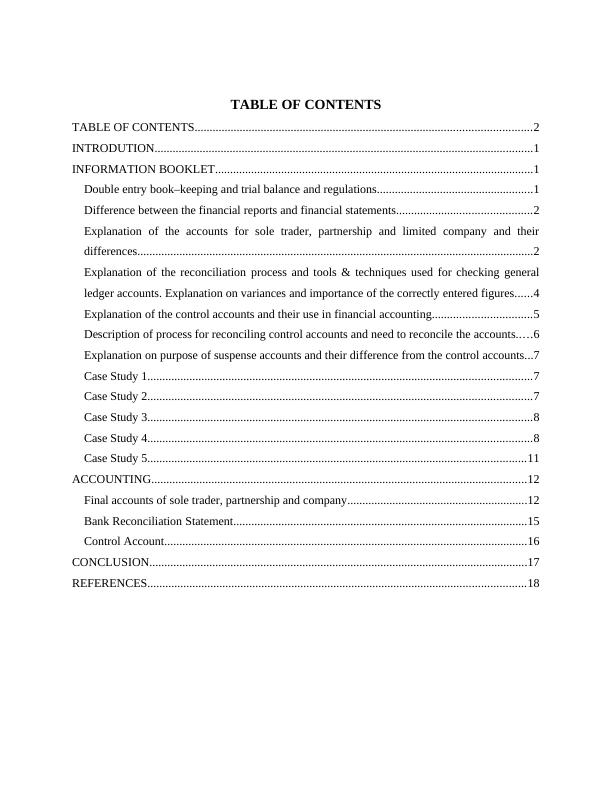
INTRODUTION
Financial accounting refers to process of preparing the financial statements which represents
the financial position and performance of the company. These financial information is useful for
both the internal management and stakeholders of the company such as creditors, investors,
suppliers and customers. Financial accounting is different from managerial accounting that
prepares financial records for the internal management of the company. Financial statements
prepared by the company are income statement, balance sheet and cash flow statements. They
are prepared by the company as per the applicable accounting standards. Present report will be
revealing about the concepts and methods of financial accounting. It will provide explanation on
double entry book keeping, financial reports and the financial statements. It will also provide
about the sole traders, partnership and limited company form of doing business. Report will
address the reconciliation process and techniques used for checking the balances of general
ledger and the use of control accounts in financial accounting. The concepts will be explained
with the help of examples and case studies. Study will enhance the understanding of financial
accounting concepts and techniques.
INFORMATION BOOKLET
Double entry book–keeping and trial balance and regulations.
Book keeping or double entry system
means that every transaction of the business
affects minimum two accounts. It is to be
recorded in at least two accounts.. It was
established for giving equal effects to the
debit and credit side of the balances. Double
entry requires the accounting equation to be
in balance i.e. assets = owner’s equity +
liabilities. This requires the balance in assets
side should be equal to the balance in
liabilities and equity side.
Trial balance is statement prepared in
double entry system containing the debits
and credit balances of all the ledger
accounts. Trial balance is prepared after
closing the ledger accounts for balancing the
debits and credit side of all the accounts of
business. Trial balance is prepared by the
business for ensuring that entries recorded
for the financial transactions in the ledger
accounts and are balanced at the end. The
debit and credit side of the trial balance
should be equal. In a double entry system
trial balance is used for the preparation of
financial statements. Balance of the accounts
in trial balance is transferred to the
respective financial statements which are
income statement and balance sheet
1
Financial accounting refers to process of preparing the financial statements which represents
the financial position and performance of the company. These financial information is useful for
both the internal management and stakeholders of the company such as creditors, investors,
suppliers and customers. Financial accounting is different from managerial accounting that
prepares financial records for the internal management of the company. Financial statements
prepared by the company are income statement, balance sheet and cash flow statements. They
are prepared by the company as per the applicable accounting standards. Present report will be
revealing about the concepts and methods of financial accounting. It will provide explanation on
double entry book keeping, financial reports and the financial statements. It will also provide
about the sole traders, partnership and limited company form of doing business. Report will
address the reconciliation process and techniques used for checking the balances of general
ledger and the use of control accounts in financial accounting. The concepts will be explained
with the help of examples and case studies. Study will enhance the understanding of financial
accounting concepts and techniques.
INFORMATION BOOKLET
Double entry book–keeping and trial balance and regulations.
Book keeping or double entry system
means that every transaction of the business
affects minimum two accounts. It is to be
recorded in at least two accounts.. It was
established for giving equal effects to the
debit and credit side of the balances. Double
entry requires the accounting equation to be
in balance i.e. assets = owner’s equity +
liabilities. This requires the balance in assets
side should be equal to the balance in
liabilities and equity side.
Trial balance is statement prepared in
double entry system containing the debits
and credit balances of all the ledger
accounts. Trial balance is prepared after
closing the ledger accounts for balancing the
debits and credit side of all the accounts of
business. Trial balance is prepared by the
business for ensuring that entries recorded
for the financial transactions in the ledger
accounts and are balanced at the end. The
debit and credit side of the trial balance
should be equal. In a double entry system
trial balance is used for the preparation of
financial statements. Balance of the accounts
in trial balance is transferred to the
respective financial statements which are
income statement and balance sheet
1
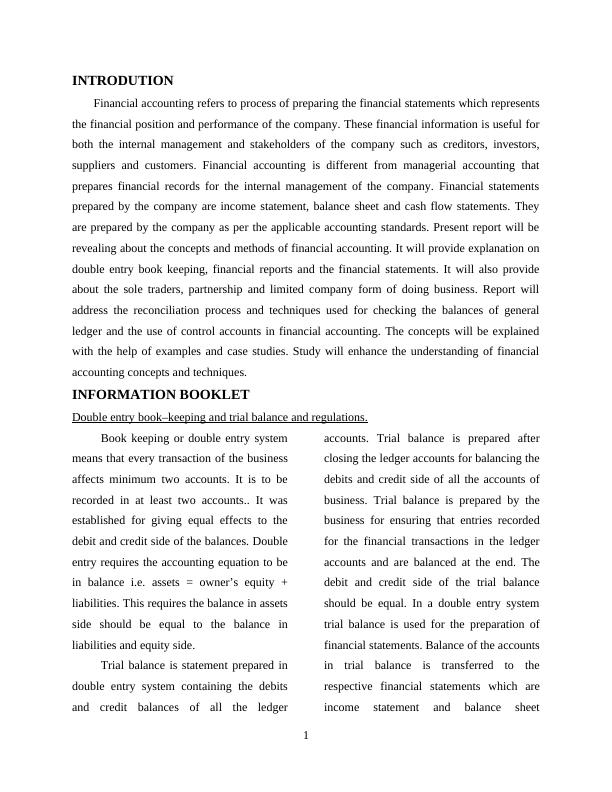
(Schroeder, Clark and Cathey, 2019).
Balance of income and expenses are
transferred in the profit or loss statement for
identifying the profitability and balances of
assets, liabilities and capital accounts are
transferred to the balance sheet for
representing the financial position of
company.
Transactions under double entry
system are governed by the accounting
standards issued by the accounting bodies.
Companies are required to comply with the
accounting standards and frameworks for
the preparation of financial statements.
Companies are required to comply with the
reporting frameworks for representing the
financial position and performance of firm
.
Difference between the financial reports and financial statements.
Financial reports and financial
statements are terms often used
interchangeably but there is difference
between the two. It could be said that
financial statements are the financial reports
where financial reports could not be said
financial statements.
Financial Reports
Financial report provides
information for the distribution to public. It
is the report on monitory matters. In other
words, financial report covers the
transaction having financial effects. For
running business financial reports provide
important information relevant for decision
making to outside and inside users (No,
2018). These bank statements, report of aged
debtors. Some of the financial reports are
made only for the internal management for
framing effective corporate strategies and
some are for external users.
Financial Statements
Financial statements on the other are
the part of financial reports. Financial
statements have more increased usage as
compared with the other financial reports.
Financial statements refer to complete set of
general purpose financial statements or
special purpose financial statements.
Financial statements include income
statement, balance sheet and cash flow
statement. Income statements provide the
performance of company during the year,
balance sheet reflects the position and the
cash flow statement provide the flow of
money inside and outside the entity. These
financial statements are governed by the
accounting boards that require the
2
Balance of income and expenses are
transferred in the profit or loss statement for
identifying the profitability and balances of
assets, liabilities and capital accounts are
transferred to the balance sheet for
representing the financial position of
company.
Transactions under double entry
system are governed by the accounting
standards issued by the accounting bodies.
Companies are required to comply with the
accounting standards and frameworks for
the preparation of financial statements.
Companies are required to comply with the
reporting frameworks for representing the
financial position and performance of firm
.
Difference between the financial reports and financial statements.
Financial reports and financial
statements are terms often used
interchangeably but there is difference
between the two. It could be said that
financial statements are the financial reports
where financial reports could not be said
financial statements.
Financial Reports
Financial report provides
information for the distribution to public. It
is the report on monitory matters. In other
words, financial report covers the
transaction having financial effects. For
running business financial reports provide
important information relevant for decision
making to outside and inside users (No,
2018). These bank statements, report of aged
debtors. Some of the financial reports are
made only for the internal management for
framing effective corporate strategies and
some are for external users.
Financial Statements
Financial statements on the other are
the part of financial reports. Financial
statements have more increased usage as
compared with the other financial reports.
Financial statements refer to complete set of
general purpose financial statements or
special purpose financial statements.
Financial statements include income
statement, balance sheet and cash flow
statement. Income statements provide the
performance of company during the year,
balance sheet reflects the position and the
cash flow statement provide the flow of
money inside and outside the entity. These
financial statements are governed by the
accounting boards that require the
2

statements to be presented in the prescribed
format.
Explanation of the accounts for sole trader, partnership and limited company and their
differences.
Sole Trader
Sole trader is a form of business
where the owner is self employed and runs
the business as individual. In sole trader
business owner is solely responsible for the
debts and obligations of the business. Sole
trader has an unlimited liability over the
business. Sole trader is not required to
prepare accounts as per the required
accounting standards. They are not required
to comply with the regulations for
preparation of financial records. There is no
prescribed format for the sole trade to
prepare its accounts. Accounts of sole trader
are prepared as per the requirement of
owners. Sole trader enjoy the whole profits
unlike the partnership and limited company.
Partnership
Partnership refers to form of
business in which 2 or more people come
together for carrying out the business.
Partners pool resources in partnership for
starting the business. Partnership is formed
on oral or written agreements on mutual
agreements of the partners. Profit and losses
are shared in the partnership firm in the ratio
agreed between them in agreements.
Partnership firms are required to prepare
accounts as per the partnership act (Robson,
Young and Power, 2017). They are not
required to prepare the financial statement as
per the accounting standards for reporting to
the public. Liability of the partners is
unlimited in the unlimited partnership and
limited in the limited partnership firm to the
extent of their contribution in the business.
In a partnership business tax is charged on
the individual income of partners and not
over the partnership firms.
Limited Company
Limited company is the organisation
set up for running a business. Unlike the
sole trader and partnership finance of the
business are separate from the personal
finances. A company is a separate legal
entity different from its owners. Company is
required to comply with all the regulations.
Companies are required to prepare financial
statements as per the accounting standards
given by the accounting bodies. For
preparation of financial statements all the
reporting framework and governing
principles are followed by the management.
Accounts of companies are audited for
3
format.
Explanation of the accounts for sole trader, partnership and limited company and their
differences.
Sole Trader
Sole trader is a form of business
where the owner is self employed and runs
the business as individual. In sole trader
business owner is solely responsible for the
debts and obligations of the business. Sole
trader has an unlimited liability over the
business. Sole trader is not required to
prepare accounts as per the required
accounting standards. They are not required
to comply with the regulations for
preparation of financial records. There is no
prescribed format for the sole trade to
prepare its accounts. Accounts of sole trader
are prepared as per the requirement of
owners. Sole trader enjoy the whole profits
unlike the partnership and limited company.
Partnership
Partnership refers to form of
business in which 2 or more people come
together for carrying out the business.
Partners pool resources in partnership for
starting the business. Partnership is formed
on oral or written agreements on mutual
agreements of the partners. Profit and losses
are shared in the partnership firm in the ratio
agreed between them in agreements.
Partnership firms are required to prepare
accounts as per the partnership act (Robson,
Young and Power, 2017). They are not
required to prepare the financial statement as
per the accounting standards for reporting to
the public. Liability of the partners is
unlimited in the unlimited partnership and
limited in the limited partnership firm to the
extent of their contribution in the business.
In a partnership business tax is charged on
the individual income of partners and not
over the partnership firms.
Limited Company
Limited company is the organisation
set up for running a business. Unlike the
sole trader and partnership finance of the
business are separate from the personal
finances. A company is a separate legal
entity different from its owners. Company is
required to comply with all the regulations.
Companies are required to prepare financial
statements as per the accounting standards
given by the accounting bodies. For
preparation of financial statements all the
reporting framework and governing
principles are followed by the management.
Accounts of companies are audited for
3
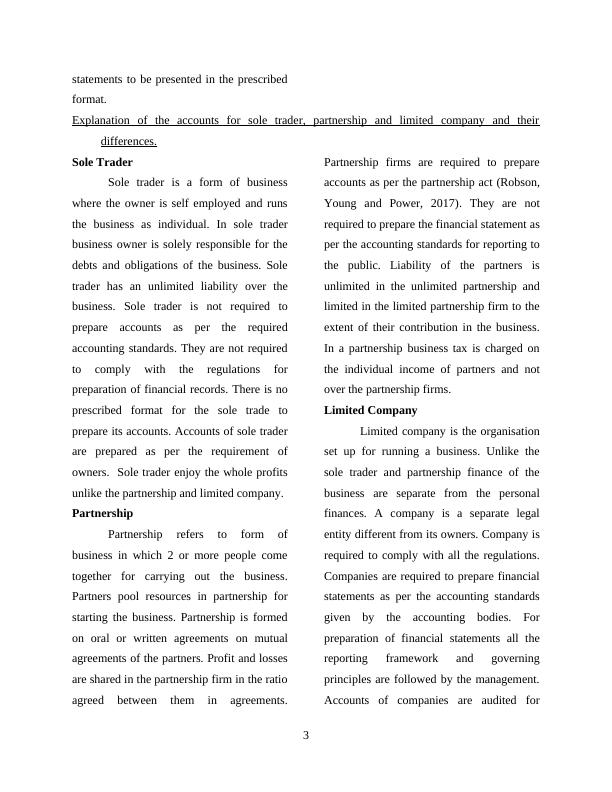
ensuring that statements are free from errors
and misstatements before they are issued to
the public. Liabilities of company do not
extend to personal assets of owners. Also the
corporation tax is charged over the profits of
company and not like sole trader and
partnership business.
Explanation of the reconciliation process and tools & techniques used for checking general
ledger accounts. Explanation on variances and importance of the correctly entered figures.
Reconciliation is described as
the process of matching the accounts
that are recorded against the monthly
statements from the external sources
like bank statements for identifying
the differences in records. It other
words it is the process which
compares 2 sets of records for
identifying that the recorded figures
are in agreement and correct (Pratt,
2016). Accounts reconciliation is also
performed for ensuring that balances
in the general ledger are accurate,
consistent and complete. Company is
required to analyse the records of
general ledgers to ensure that they ar
correctly recorded and are free from
material misstatements.
Reconciliation process includes
reconciling the accounts of ledger with the
bank statement for ensuring that all the
entries are correctly recorded. There are
cases where the entries are recorded in cash
ledger of company but are not recorded in
the bank statement due to delay or errors. in
the bank reconciliation statement entries
recorded in the bank ledger and not in bank
statements are adjusted and vice versa. The
reconciliation process allows teh company
to identify the errors done on bank side and
identifying the frauds if any committed by
the employees of company. Trial balance is
also prepared for identifying that the balance
sin the ledger accounts are identified when
the balance of debit side is not equal to the
credit side.
Reconciliation should be performed on
regular basis for ensuring the integrity of the
financial records. It helps to uncover the
omission, theft, duplication and the
fraudulent transactions.
Document review is the method
involving review of the existing transactions
and documents for making sure that amount
recorded is actual amount spent. This review
is generally carried out with the help of
software (Narayanaswamy, 2017). For
example for reviewing the receipts and
identifying the discrepancies. It reconciles
the accounts with the actual invoices of the
4
and misstatements before they are issued to
the public. Liabilities of company do not
extend to personal assets of owners. Also the
corporation tax is charged over the profits of
company and not like sole trader and
partnership business.
Explanation of the reconciliation process and tools & techniques used for checking general
ledger accounts. Explanation on variances and importance of the correctly entered figures.
Reconciliation is described as
the process of matching the accounts
that are recorded against the monthly
statements from the external sources
like bank statements for identifying
the differences in records. It other
words it is the process which
compares 2 sets of records for
identifying that the recorded figures
are in agreement and correct (Pratt,
2016). Accounts reconciliation is also
performed for ensuring that balances
in the general ledger are accurate,
consistent and complete. Company is
required to analyse the records of
general ledgers to ensure that they ar
correctly recorded and are free from
material misstatements.
Reconciliation process includes
reconciling the accounts of ledger with the
bank statement for ensuring that all the
entries are correctly recorded. There are
cases where the entries are recorded in cash
ledger of company but are not recorded in
the bank statement due to delay or errors. in
the bank reconciliation statement entries
recorded in the bank ledger and not in bank
statements are adjusted and vice versa. The
reconciliation process allows teh company
to identify the errors done on bank side and
identifying the frauds if any committed by
the employees of company. Trial balance is
also prepared for identifying that the balance
sin the ledger accounts are identified when
the balance of debit side is not equal to the
credit side.
Reconciliation should be performed on
regular basis for ensuring the integrity of the
financial records. It helps to uncover the
omission, theft, duplication and the
fraudulent transactions.
Document review is the method
involving review of the existing transactions
and documents for making sure that amount
recorded is actual amount spent. This review
is generally carried out with the help of
software (Narayanaswamy, 2017). For
example for reviewing the receipts and
identifying the discrepancies. It reconciles
the accounts with the actual invoices of the
4
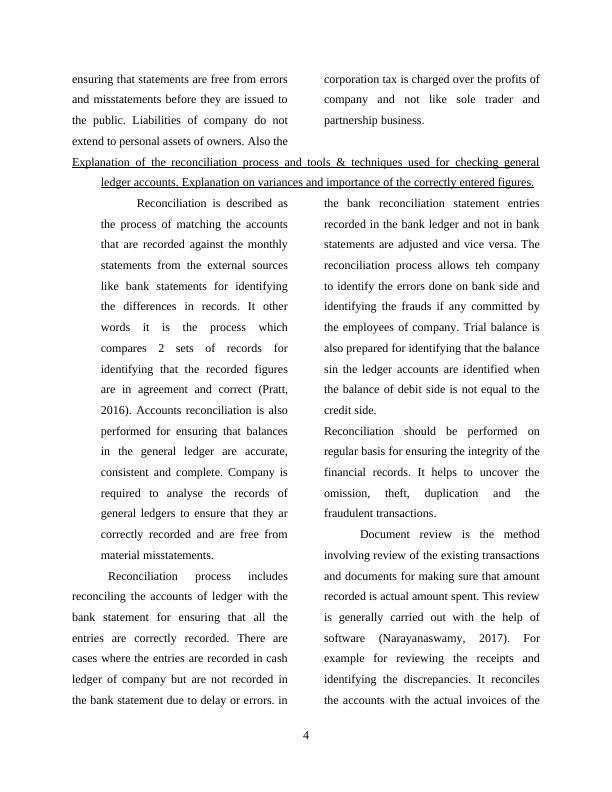
End of preview
Want to access all the pages? Upload your documents or become a member.
Related Documents
Financial Accountinglg...
|20
|4294
|65
Financial Accounting INTRODUCTION 1 TASK 11 Question 1 2 7 TASK 29 Question 1 2 7 CONCLUSION 11 REFERENCES 12 INTRODUCTIONlg...
|14
|1243
|343
Level 5 Higher National diploma: Unit 10 - Financial Accountinglg...
|37
|8455
|8
FINANCIAL ACCOUNTING PRINCIPLE INTROUCTION 1 PART A1 Business Reportlg...
|36
|9395
|326
Financial Accounting: Record Transactions and Prepare Final Accountslg...
|33
|7917
|68
Assignment Front Sheet Learner Name Learner Student I.D. Assessor Name Navroop Sandhu 1017470 Mr. LAMlg...
|36
|9707
|279
